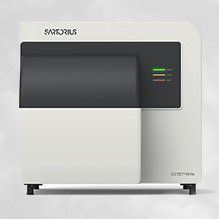1 6-Channcel High Throughput Octer Systems: Octet RH16 System
High Throughput Platform for Biologics Development

Point of Product
Benefits
1. Supports 96-well and 384-well microplate formats
Use up to 384 samples in one 384-well microplate for kinetics analysis
2. Two microplate locations to maximize throughput and improve workflow
3. Microfluidics-free Dip and Read format reduces assay time and maintenance cost
The Octet RH16 system utilizes Dip and Read™ technology with the read head dipping into samples in a plate format. With no fluidics involved, the Octet RH16 system has more uptime and a lower cost of maintenance.
Applications
ELISA Conversion
ELISAs are known for having variability in results, susceptibility to human error, and slow times-to-results. High throughput Octet systems are designed to overcome those limitations. Convert your ELISA assay into an Octet assay.
Epitope Binning
Epitope binning studies rely on the sequential binding of two antibodies to an antigen, and are performed using dozens of antibody pairs in cross-competition matrices. The Octet system excels at these large-scale studies due to assay speed, throughput, and exceptional reproducibility
Protein Contaminant Testing
Protein contaminants are a major hurdle to overcome during the production of biopharmaceuticals. The Octet platform's rapid high throughput protein analysis combined with the anti-CHO HCP and Residual Protein A kits provide biologics developers with a rapid and easy to use technique for contaminant testing.
Specification
|
Technology
|
Bio-Layer
Interferometry (BLI) based on fiber optic biosensors
|
|
Sample
volume
|
40–80
μL/well (384-well tilted bottom microplate) and 180–220 μL/well (96-well
microplate), nondestructive testing, easily recovered
|
|
Data
presentation
|
Plots
displaying kinetic binding, equation fits, and residuals of fits Tabulated
kinetic data and data charts
|
|
Automation
|
Robot
compatible microplate and biosensor tray loading
|
|
Orbital
flow capacity
|
Static
or 100–1500 rpm
|
|
Analysis
temperature
|
Ambient
+ 4°C to 40°C, in 1°C increments
|
|
Association
rate constant (ka)
|
101 to 107 M-1 s-1 |
|
Dissociation
rate constant (kd)
|
10-6 to 10-1 s-1 |
|
Affinity
constant (KD)
|
1
mM to 10 pM
|
|
Baseline
noise (RMS)
|
≤ 4
pm (RMS)
|
|
Baseline
drift
|
<
0.1 nm/hour
|
|
Quantitation
range
|
8–16
biosensors: 0.05–300 μg/mL of hIgG at 1000 rpm**; 0.5–2000 μg/mL at 400 rpm
|
|
Quantitation
precision
|
CV
<10%
|
|
Weight
|
150
lb (68.2 Kg)
|
|
Dimensions
(H x W x D)
|
30.1"
H x 31.5" W x 31.5" D (77 cm H x 80 cm W x 80 cm D)
|
|
Sample
type
|
Proteins,
antibodies, peptides, serum containing media (up to 25%), DMSO containing
buffers, virus-like particles, untreated cell culture supernatants and crude
cell lysates
|
|
Sample
plate
|
Standard,
96-well and 384-well, black, tilted bottom microplates
|
|
Molecular
weight detection
|
>150
Da (8–16 biosensors)
|
